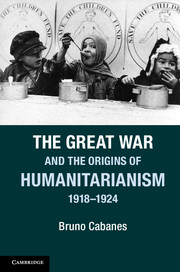Book contents
- Frontmatter
- Contents
- Acknowledgments
- Introduction Human disasters: humanitarianism and the transnational turn in the wake of World War I
- 1 “Rights, not charity”: René Cassin and war victims
- 2 Justice and peace: Albert Thomas, the International Labor Organization, and the dream of a transnational politics of social rights
- 3 The tragedy of being stateless: Fridtjof Nansen and the rights of refugees
- 4 The hungry and the sick: Herbert Hoover, the Russian famine, and the professionalization of humanitarian aid
- 5 Humanitarianism old and new: Eglantyne Jebb and children's rights
- Conclusion Human dignity: from humanitarian rights to human rights
- Further reading
- Bibliography
- Index
- References
1 - “Rights, not charity”: René Cassin and war victims
Published online by Cambridge University Press: 05 June 2014
- Frontmatter
- Contents
- Acknowledgments
- Introduction Human disasters: humanitarianism and the transnational turn in the wake of World War I
- 1 “Rights, not charity”: René Cassin and war victims
- 2 Justice and peace: Albert Thomas, the International Labor Organization, and the dream of a transnational politics of social rights
- 3 The tragedy of being stateless: Fridtjof Nansen and the rights of refugees
- 4 The hungry and the sick: Herbert Hoover, the Russian famine, and the professionalization of humanitarian aid
- 5 Humanitarianism old and new: Eglantyne Jebb and children's rights
- Conclusion Human dignity: from humanitarian rights to human rights
- Further reading
- Bibliography
- Index
- References
Summary
“The war left deep and permanent scars on me, and on many of my comrades…I could not accept the idea that national solidarity towards disabled veterans would be restricted to a kind of charitable handout.”
René Cassin, Nobel Peace Prize Lecture, Oslo, December 10, 1968At the end of World War I, an entire generation of veterans struggled to return to civilian life. Their ranks had been decimated by the considerable losses sustained during the conflict. In Europe, 10 million men lost their lives in combat; 20 million were wounded; 8 million suffered from various kinds of disabilities. The families who welcomed them home were often at a loss to cope with the severity of the soldiers’ injuries and trauma, with their own inability to care for them, and with the impossibility of returning to pre-war life. These psychological problems were compounded by economic difficulties when a demobilized soldier was disabled, or when a family's principal provider had been killed in action. Widows, often young, numbered in the millions. There were nearly 6 million orphans when the Armistice was signed, and likely 3 million more in the years that followed, as veterans died from the consequences of their injuries.
- Type
- Chapter
- Information
- Publisher: Cambridge University PressPrint publication year: 2014



